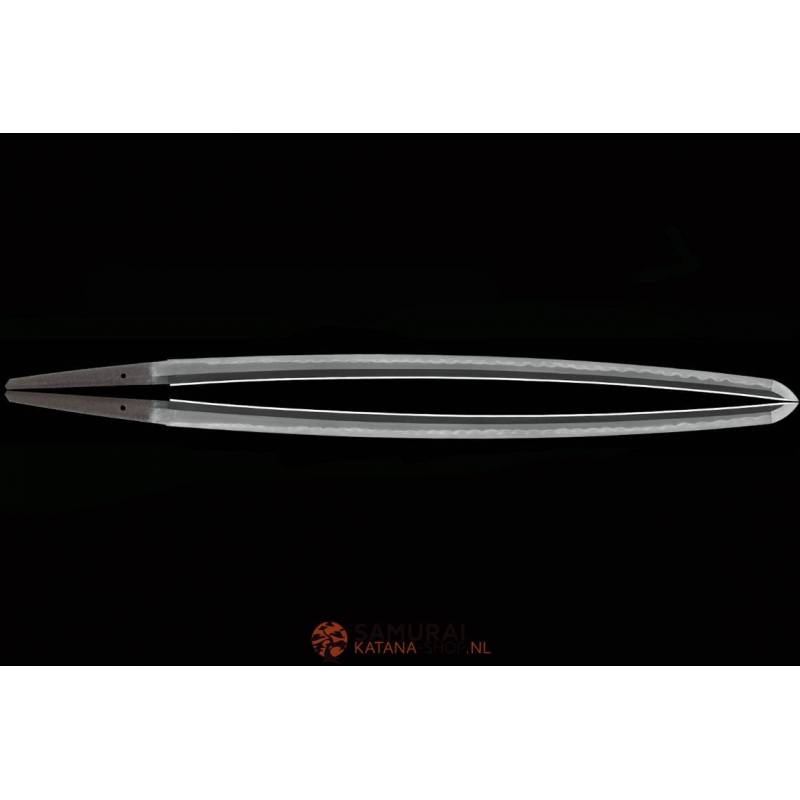


















Buy this unique and breathtaking Japanese Katana from Yamashiro Kami Fujiwara Nobutoshi with NBTHK Hozon papers and Tokubetsu Kicho Token papers.
Sold!
Yamashiro Kami Fujiwara Nobutoshi
This unique and breathtaking katana by Yamashiro Kami Fujiwara Nobutoshi with the honorific of Harima No Daijo lived in the Tenna period. Tenna was a period after Enpo and before Jōkyō (September 1681 to February 1684). The emperor was Reigen-tennō, but real power lay with the Tokugawa shogunate and the country's 300 regional daimyos. A daimyo belonged to the samurai class and was a Japanese warlord.
A real authentic Japanese sword with a lot of history and given the beautiful appearance it does not take much effort to imagine a Samurai with this beautiful sword.
The Japanese swordsmith Yamashiro Kami Fujiwara Nobutoshi comes from the Mishina school, he lived in Heianjô. The mishina is descended from Shoshu Masamune. Kanemichi founded the Mishina School in Mino Province during the late Muromachi period. He moved to Yamashiro in the late Muromachi or early Shinto period. His blades were known for their extreme sharpness and quality and were rated as upper class. Due to his success, he was given the title Kami and was given permission to use it in his signature of May.
The Mei or signature is Yamashiro (prefecture) Kami (honorary title) Fujiwara (clan) Nobutoshi (name). He also often signed with a mon/chrysanthemum on the nakago.
It remains a miracle that despite its age this sword is in excellent condition. The blade forged from tamahagane has a fairly deep sori and a beautiful connecting kissaki that is on the longer side. An ubu nakago or tang that has not been shortened and is therefore still in the condition as it was forged. Forged tamagagane with a refined hada in ko-itame in ji-nie. Much life in the leaf with chikei and hadame. Chikei arises from the ji-nie and its particles that appear on the hardened steel. By repeatedly heating, folding and hammering the steel to expel any impurities and air bubbles that could affect the strength of the finished blade, you will get the very clear hadame visible. A suguha hamon that turns into a gunome midare and round bo-shi. The jigane is very powerful and comes out nicely.
The suguta is shinogi zukuri with a kengyo nakago or tang with 1 mekugi-ana. The inscription is carefully applied and provided with yasurime or file patterns. This implies that the blacksmith was satisfied with his work and indicates that it did not belong to mass production.
Of course, this samurai sword comes with a matching koshirae. The black rorio saya (sheath) with leading red stripes make this a very attractive Japanese katana that you won't find a second of.
The tsuba is a Dote-Mimi design and since it is still a tsuba in early Edo, it doesn't look too flashy. You can also see a mei or signature on the tsuba. The handle is wrapped in Katate maki with a family of mon in shakudo on the menuki. The sober higo style fuchi and kashira have a floral theme, but contrast nicely with the leather ito on real rayskin.
Nagasa : 68.5 cm
Sori :1.6 cm
Width at the hamachi : 2,8 cm
Width at the Kissaki : 2.05 cm
Kasane : 7.6 mm
Weight: 715 grams
An opportunity to buy a beautiful real Japanese samurai sword. A unique and beautiful piece of history from Japan and what an honor to be able to sell this.
This Nihonto deserves somewhere where it will be treated with honor and respect.
Apart from the fact that this is a great sword to display in your home, I can tell you with certainty that it is a good investment and will hold its value. We are not the only ones who see that this is a precious Japanese sword but also the NBTHK. The sword is not only provided with Hozon papers but also with NBTHK Tokubetsu Kicho Token. NBTHK Tokubetsu Kicho Token Especially Precious (deep green paper - Particularly precious). It has long been the highest rank in the NBTHK organization.
Including Oshigata. Oshigata is a drawing of the blade which records all the metallurgical activities of the blade so that a good picture is created of the unique katana.
This is an antique sword and is therefore subject to the test of time and this will therefore be visible in some places.
Of course provided with NBTHK Hozon and Tokubetsu Kicho Token papers which guarantee the authenticity.
Never touch the katana with bare hands
Do not breathe in the direction of the blade
Do not rest the Katana on the kissaki
When indicating the katana do not point the point and cut towards the indicated person
When throwing up the katana it is recommended to do this in the saya